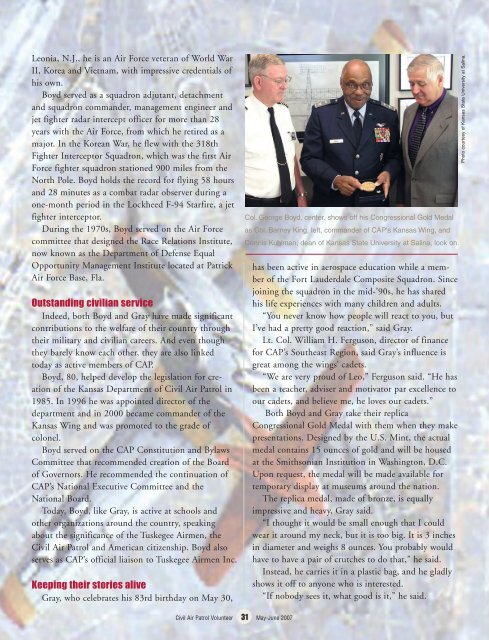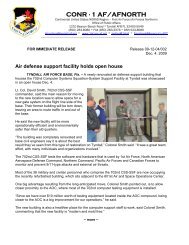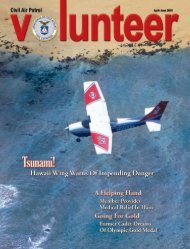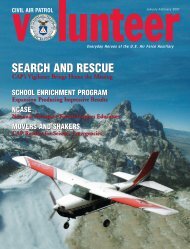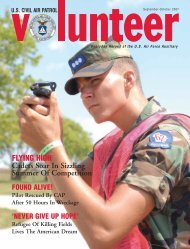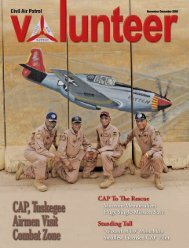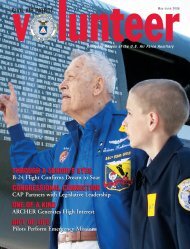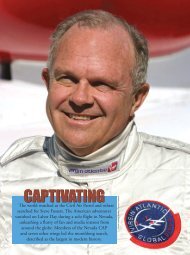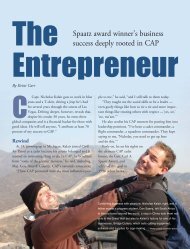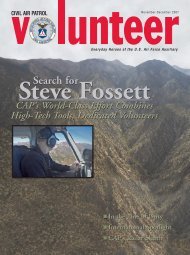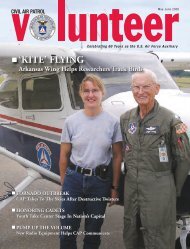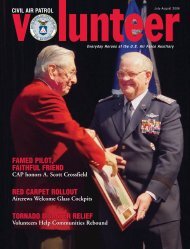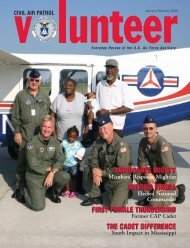CAPITAL CLOSE-UP
Hi-res - CAP VolunteerNow
Hi-res - CAP VolunteerNow
- No tags were found...
Create successful ePaper yourself
Turn your PDF publications into a flip-book with our unique Google optimized e-Paper software.
Leonia, N.J., he is an Air Force veteran of World War<br />
II, Korea and Vietnam, with impressive credentials of<br />
his own.<br />
Boyd served as a squadron adjutant, detachment<br />
and squadron commander, management engineer and<br />
jet fighter radar intercept officer for more than 28<br />
years with the Air Force, from which he retired as a<br />
major. In the Korean War, he flew with the 318th<br />
Fighter Interceptor Squadron, which was the first Air<br />
Force fighter squadron stationed 900 miles from the<br />
North Pole. Boyd holds the record for flying 58 hours<br />
and 28 minutes as a combat radar observer during a<br />
one-month period in the Lockheed F-94 Starfire, a jet<br />
fighter interceptor.<br />
During the 1970s, Boyd served on the Air Force<br />
committee that designed the Race Relations Institute,<br />
now known as the Department of Defense Equal<br />
Opportunity Management Institute located at Patrick<br />
Air Force Base, Fla.<br />
Outstanding civilian service<br />
Indeed, both Boyd and Gray have made significant<br />
contributions to the welfare of their country through<br />
their military and civilian careers. And even though<br />
they barely know each other, they are also linked<br />
today as active members of CAP.<br />
Boyd, 80, helped develop the legislation for creation<br />
of the Kansas Department of Civil Air Patrol in<br />
1985. In 1996 he was appointed director of the<br />
department and in 2000 became commander of the<br />
Kansas Wing and was promoted to the grade of<br />
colonel.<br />
Boyd served on the CAP Constitution and Bylaws<br />
Committee that recommended creation of the Board<br />
of Governors. He recommended the continuation of<br />
CAP’s National Executive Committee and the<br />
National Board.<br />
Today, Boyd, like Gray, is active at schools and<br />
other organizations around the country, speaking<br />
about the significance of the Tuskegee Airmen, the<br />
Civil Air Patrol and American citizenship. Boyd also<br />
serves as CAP’s official liaison to Tuskegee Airmen Inc.<br />
Keeping their stories alive<br />
Gray, who celebrates his 83rd birthday on May 30,<br />
Col. George Boyd, center, shows off his Congressional Gold Medal<br />
as Col. Barney King, left, commander of CAP's Kansas Wing, and<br />
Dennis Kuhlman, dean of Kansas State University at Salina, look on.<br />
has been active in aerospace education while a member<br />
of the Fort Lauderdale Composite Squadron. Since<br />
joining the squadron in the mid-’90s, he has shared<br />
his life experiences with many children and adults.<br />
“You never know how people will react to you, but<br />
I’ve had a pretty good reaction,” said Gray.<br />
Lt. Col. William H. Ferguson, director of finance<br />
for CAP’s Southeast Region, said Gray’s influence is<br />
great among the wings’ cadets.<br />
“We are very proud of Leo,” Ferguson said. “He has<br />
been a teacher, adviser and motivator par excellence to<br />
our cadets, and believe me, he loves our cadets.”<br />
Both Boyd and Gray take their replica<br />
Congressional Gold Medal with them when they make<br />
presentations. Designed by the U.S. Mint, the actual<br />
medal contains 15 ounces of gold and will be housed<br />
at the Smithsonian Institution in Washington, D.C.<br />
Upon request, the medal will be made available for<br />
temporary display at museums around the nation.<br />
The replica medal, made of bronze, is equally<br />
impressive and heavy, Gray said.<br />
“I thought it would be small enough that I could<br />
wear it around my neck, but it is too big. It is 3 inches<br />
in diameter and weighs 8 ounces. You probably would<br />
have to have a pair of crutches to do that,” he said.<br />
Instead, he carries it in a plastic bag, and he gladly<br />
shows it off to anyone who is interested.<br />
“If nobody sees it, what good is it,” he said. ▲<br />
Photo courtesy of Kansas State University at Salina.<br />
Civil Air Patrol Volunteer 31 May-June 2007


